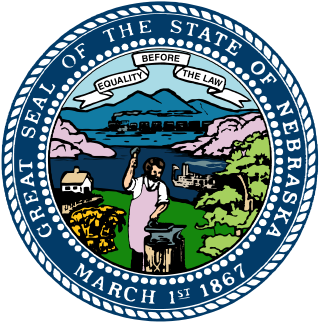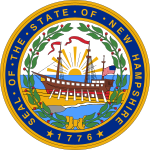
Charles Albert Busiel was an American manufacturer, politician, and the 45th governor of New Hampshire.
The Massachusetts Republican Party (MassGOP) is the Massachusetts branch of the U.S. Republican Party.

The 1894 New York state election was held on November 6, 1894, to elect the governor, the lieutenant governor and a judge of the New York Court of Appeals, as well as all members of the New York State Assembly. Besides, a new State Constitution and four other constitutional amendments were proposed to the electorate, and were all accepted. Furthermore, the inhabitants of New York County and adjacent communities were asked if they wanted to join the proposed enlarged New York City, a project known as The Consolidation.

The 1938 Oregon gubernatorial election took place on November 8, 1938. In the election for governor of Oregon, Republican nominee Charles A. Sprague defeated Democratic nominee Henry L. Hess. Incumbent governor Charles Martin lost in the Democratic primary to Hess, an attorney and former state senator from La Grande. Hess was a strong supporter of President Franklin Delano Roosevelt's New Deal while Martin was a frequent critic of the program.

The 1894 South Dakota gubernatorial election was held on November 6, 1894. Incumbent Republican Governor Charles H. Sheldon ran for re-election to a second term. Despite facing a thread of defeat at the Republican convention, Sheldon was renominated unanimously. In the general election, he faced Populist nominee Isaac Howe, a Spink County Judge; James A. Ward, the former state chairman of the South Dakota Democratic Party; and Prohibition nominee M. D. Alexander. The election was largely a replay of the gubernatorial elections of 1890 and 1892, with the Farmers' Alliance candidate placing second and the Democratic nominee placing a distant third. This time, however, Sheldon won an outright majority and the Democratic Party's vote share shrunk to just 11%, its worst performance in state history.

The 1904 South Dakota gubernatorial election was held on November 8, 1904. Incumbent Republican Governor Charles N. Herreid declined to run for re-election to a third term. Clark County State's Attorney Samuel H. Elrod won the Republican nomination to run as Herreid's successor, and he faced Democratic nominee Louis N. Crill, the former president of the state Senate, and former U.S. Congressman Freeman Knowles, the Socialist nominee. For the first time since 1894, the Democratic and Populist Parties nominated separate candidates. Ultimately, the split in the two parties did not prove dispositive; Elrod defeated Crill and the other candidates in a landslide.

The 1872 United States presidential election in Maryland took place on November 5, 1872. All contemporary 37 states were part of the 1872 United States presidential election. The state voters chose eight electors to the Electoral College, which selected the president and vice president.

The 1944 Washington gubernatorial election was held on November 7, 1944. Democratic nominee Monrad Wallgren defeated incumbent Republican Arthur B. Langlie with 51.51% of the vote.

The 1920 New Hampshire gubernatorial election was held on November 2, 1920. Republican nominee Albert O. Brown defeated Democratic nominee Charles E. Tilton with 59.59% of the vote.

The 1896 New Hampshire gubernatorial election was held on November 3, 1896. Republican nominee George A. Ramsdell defeated Democratic nominee Henry O. Kent with 61.41% of the vote.

The 1894 Rhode Island gubernatorial election was held on April 4, 1894. Incumbent Republican Daniel Russell Brown defeated Democratic nominee David S. Baker with 53.15% of the vote.

The April 1876 Connecticut gubernatorial election was held on April 3, 1876. Incumbent governor and Democratic nominee Charles R. Ingersoll defeated Republican nominee H. Robinson with 51.85% of the vote.

The 1874 Connecticut gubernatorial election was held on April 6, 1874. Incumbent governor and Democratic nominee Charles R. Ingersoll defeated Republican nominee Henry B. Harrison with 50.87% of the vote.

The 1873 Connecticut gubernatorial election was held on April 7, 1873. Former state legislator and Democratic nominee Charles R. Ingersoll defeated Republican nominee Henry P. Haven with 51.86% of the vote.

The 1926 Wisconsin gubernatorial election was held on November 2, 1926. Primary elections were held on September 7, 1926.

A general election was held in the U.S. state of Wyoming on Tuesday, November 6, 1894. All of the state's executive officers—the Governor, Secretary of State, Auditor, Treasurer, and Superintendent of Public Instruction—were up for election. The Republican Party, helped by the strong performance of the Populist Party, which operated as a spoiler to the Democratic Party, won back the governorship and improved its margin of victory in all other statewide offices.

A general election was held in the U.S. state of Wyoming on Tuesday, November 8, 1898. All of the state's executive officers—the Governor, Secretary of State, Auditor, Treasurer, and Superintendent of Public Instruction—were up for election. The Republican Party retained all of the offices up for election, though by reduced margins from 1894 as the Populist Party's performance decreased considerably.

The 1896 Delaware gubernatorial election was held on November 3, 1896. Shortly after his victory in the 1894 gubernatorial election, Republican Governor Joshua H. Marvil died. State Senate Speaker William T. Watson, a Democrat, became Governor and a new election for a full four-year term was scheduled in 1896. Though Watson was considered a potential candidate for re-election, the Democratic convention instead nominated Ebe W. Tunnell, the 1894 nominee for Governor; despite his protests that he would decline the nomination, Tunnell ultimately accepted it.

The 1894 Wisconsin gubernatorial election was held on November 6, 1894.

The 1900 Nebraska gubernatorial election was held on November 6, 1900.





















